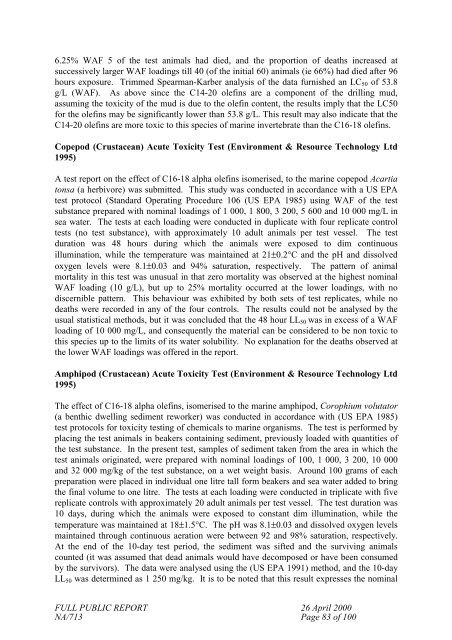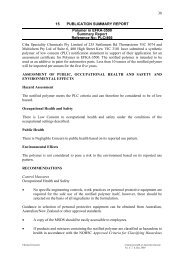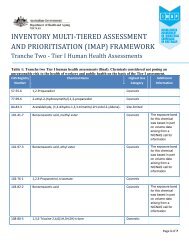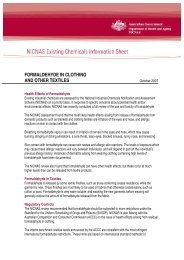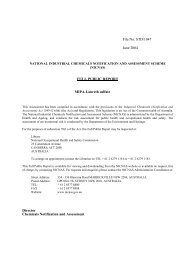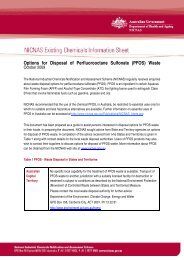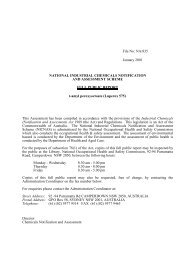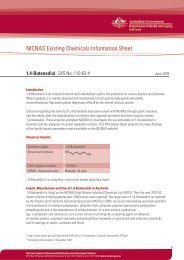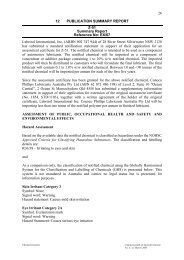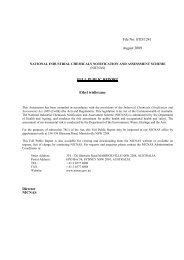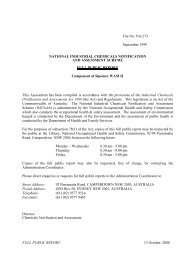GULFTENE C16-18 ISOMERISED OLEFINS - NICNAS
GULFTENE C16-18 ISOMERISED OLEFINS - NICNAS
GULFTENE C16-18 ISOMERISED OLEFINS - NICNAS
Create successful ePaper yourself
Turn your PDF publications into a flip-book with our unique Google optimized e-Paper software.
6.25% WAF 5 of the test animals had died, and the proportion of deaths increased at<br />
successively larger WAF loadings till 40 (of the initial 60) animals (ie 66%) had died after 96<br />
hours exposure. Trimmed Spearman-Karber analysis of the data furnished an LC50 of 53.8<br />
g/L (WAF). As above since the C14-20 olefins are a component of the drilling mud,<br />
assuming the toxicity of the mud is due to the olefin content, the results imply that the LC50<br />
for the olefins may be significantly lower than 53.8 g/L. This result may also indicate that the<br />
C14-20 olefins are more toxic to this species of marine invertebrate than the <strong>C16</strong>-<strong>18</strong> olefins.<br />
Copepod (Crustacean) Acute Toxicity Test (Environment & Resource Technology Ltd<br />
1995)<br />
A test report on the effect of <strong>C16</strong>-<strong>18</strong> alpha olefins isomerised, to the marine copepod Acartia<br />
tonsa (a herbivore) was submitted. This study was conducted in accordance with a US EPA<br />
test protocol (Standard Operating Procedure 106 (US EPA 1985) using WAF of the test<br />
substance prepared with nominal loadings of 1 000, 1 800, 3 200, 5 600 and 10 000 mg/L in<br />
sea water. The tests at each loading were conducted in duplicate with four replicate control<br />
tests (no test substance), with approximately 10 adult animals per test vessel. The test<br />
duration was 48 hours during which the animals were exposed to dim continuous<br />
illumination, while the temperature was maintained at 21±0.2°C and the pH and dissolved<br />
oxygen levels were 8.1±0.03 and 94% saturation, respectively. The pattern of animal<br />
mortality in this test was unusual in that zero mortality was observed at the highest nominal<br />
WAF loading (10 g/L), but up to 25% mortality occurred at the lower loadings, with no<br />
discernible pattern. This behaviour was exhibited by both sets of test replicates, while no<br />
deaths were recorded in any of the four controls. The results could not be analysed by the<br />
usual statistical methods, but it was concluded that the 48 hour LL50 was in excess of a WAF<br />
loading of 10 000 mg/L, and consequently the material can be considered to be non toxic to<br />
this species up to the limits of its water solubility. No explanation for the deaths observed at<br />
the lower WAF loadings was offered in the report.<br />
Amphipod (Crustacean) Acute Toxicity Test (Environment & Resource Technology Ltd<br />
1995)<br />
The effect of <strong>C16</strong>-<strong>18</strong> alpha olefins, isomerised to the marine amphipod, Corophium volutator<br />
(a benthic dwelling sediment reworker) was conducted in accordance with (US EPA 1985)<br />
test protocols for toxicity testing of chemicals to marine organisms. The test is performed by<br />
placing the test animals in beakers containing sediment, previously loaded with quantities of<br />
the test substance. In the present test, samples of sediment taken from the area in which the<br />
test animals originated, were prepared with nominal loadings of 100, 1 000, 3 200, 10 000<br />
and 32 000 mg/kg of the test substance, on a wet weight basis. Around 100 grams of each<br />
preparation were placed in individual one litre tall form beakers and sea water added to bring<br />
the final volume to one litre. The tests at each loading were conducted in triplicate with five<br />
replicate controls with approximately 20 adult animals per test vessel. The test duration was<br />
10 days, during which the animals were exposed to constant dim illumination, while the<br />
temperature was maintained at <strong>18</strong>±1.5°C. The pH was 8.1±0.03 and dissolved oxygen levels<br />
maintained through continuous aeration were between 92 and 98% saturation, respectively.<br />
At the end of the 10-day test period, the sediment was sifted and the surviving animals<br />
counted (it was assumed that dead animals would have decomposed or have been consumed<br />
by the survivors). The data were analysed using the (US EPA 1991) method, and the 10-day<br />
LL50 was determined as 1 250 mg/kg. It is to be noted that this result expresses the nominal<br />
FULL PUBLIC REPORT 26 April 2000<br />
NA/713 Page 83 of 100


